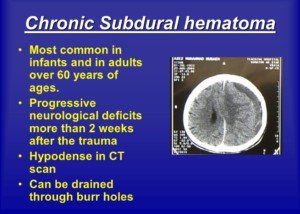Yes, there tends to be differences in symptoms of chronic subdural hematoma in young patients vs. elderly.
A report in the journal Injury points out differences in symptom presentation of chronic subdural hematoma in young patients (under age 40) and elderly (over age 75).
Young Patients with Chronic Subdural Hematoma
The researchers observed particular characteristics of symptoms: a higher incidence of headache, and a higher incidence of vomiting, along with a shorter time span between initial trauma and corrective surgery.
Elderly Patients
They tended to have symptoms relating to change in mental status, deficits in motor control and larger collections of blood in the brain.
Pertaining to the patients in this analysis, there was no statistically significant difference in the rate of surgical complications.
Just what is a chronic subdural hematoma?

Depiction of a subdural hematoma. Scientific Animations, CC/BY-SA/Attribution-ShareAlike 4.0 International
A chronic subdural hematoma is a type of brain injury where blood collects between the brain’s surface and the dura mater, the outermost layer of the protective coverings of the brain.
It’s significantly more common in people over 65 vs. middle age and especially younger adults.
Unlike an acute subdural hematoma, which occurs suddenly due to trauma and involves rapid bleeding, a chronic subdural hematoma develops over weeks or months.
This slower progression happens when small veins between the brain and the dura mater are torn, often due to minor head trauma or even spontaneously, particularly in individuals with weakened blood vessels or elderly people on blood thinners.
Brain shrinkage due to age is the primary reason people over 65 are much more likely to suffer from a chronic subdural hematoma.










































